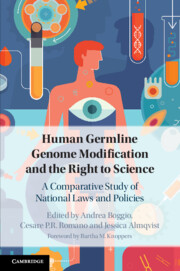 Human Germline Genome Modification and the Right to Science
Human Germline Genome Modification and the Right to Science Published online by Cambridge University Press: 15 November 2019
In this chapter, we review the key elements of the larger international and transnational framework within which the national legal regimes regulating human germline genome modification exist. Part I is a quick primer to international law and international human rights for the benefit of those who are not familiar with them. Part II presents the relevant norms of international bioethics law, including three main declarations adopted by UNESCO touching on human genome modification. It discusses also the relevant governance activities of the World Health Organization, Organisation for Economic Co-operation and Development and civil society, nationally and transnationally. Part III discusses relevant international human standards, and in particular the so-called ‘right to science’ and the ‘rights of science’. Finally, Part IV discusses how these rights can contribute to the emerging international regulatory framework. This chapter argues that, by itself, international bioethics law and its instruments provide a narrow and inadequate description of the range of human rights that must be taken into account in the conversation on the regulation of germline engineering. These instruments must be integrated with the broader international human rights law corpus. When they are integrated, five key principles emerge as foundations of the emerging regulatory framework: freedom of research; benefit sharing; solidarity; respect for dignity; and the obligation to respect and to protect the rights and individual freedoms of others.
To save this book to your Kindle, first ensure [email protected] is added to your Approved Personal Document E-mail List under your Personal Document Settings on the Manage Your Content and Devices page of your Amazon account. Then enter the ‘name’ part of your Kindle email address below. Find out more about saving to your Kindle.
Note you can select to save to either the @free.kindle.com or @kindle.com variations. ‘@free.kindle.com’ emails are free but can only be saved to your device when it is connected to wi-fi. ‘@kindle.com’ emails can be delivered even when you are not connected to wi-fi, but note that service fees apply.
Find out more about the Kindle Personal Document Service.
To save content items to your account, please confirm that you agree to abide by our usage policies. If this is the first time you use this feature, you will be asked to authorise Cambridge Core to connect with your account. Find out more about saving content to Dropbox.
To save content items to your account, please confirm that you agree to abide by our usage policies. If this is the first time you use this feature, you will be asked to authorise Cambridge Core to connect with your account. Find out more about saving content to Google Drive.